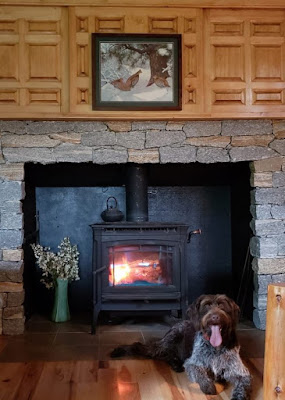If
you want an endless discussion, maybe even an argument, bring up the subject of
shot size at grouse camp. Should the conversation start to slow, ask what
everyone recommends for choke constriction.
As
a young hunter, I was impressed by horsepower, and that meant high brass
loads with number six shot for grouse. My first shotgun, an old Ithaca
side-by-side was choked modified and full. Luckily for the grouse, I seldom hit
them, but if I did there wasn’t a lot left. One of the first ones I ever shot was also
shot by my brother at the exact same instant. We picked up the pieces without either
of us realizing the other had shot too. Cleaning what remained of the bird
later, there was both my number six and his seven and a half shot in the
shredded carcass.
 Number
six shot is overkill for grouse, even late in the season when their feathers have
toughened up. Number eights are my choice through the first two months of the
season, and maybe I’ll switch to seven and a halfs later when the birds toughen
up in December.
Number
six shot is overkill for grouse, even late in the season when their feathers have
toughened up. Number eights are my choice through the first two months of the
season, and maybe I’ll switch to seven and a halfs later when the birds toughen
up in December.
There’s
a lot more pellets in a load of number eights than seven and a halfs, about 17%
more, and grouse are not difficult to kill. With more pellets a few are bound
to find their way through those early season leaves. And if a woodcock is put
up you want a lot of pellets in the air or the bird may escape through a hole
in the pattern. Some early season hunters like number 9 shot for woodcock,
which has about 40% more pellets than a same weight load of number eights.
It
is always a good idea to pattern your shotgun to see what different loads do. The
first few weeks of the season, when the leaves are still thick and the shots
close, spreader loads like Double-Wide by Polywad and Spreader-Lite by RST may
increase your bag. On opening day, I like a Double-Wide in the right barrel and
a regular seven-eighths ounce load in the left of my twenty gauge, both in
number eight shot.
All
through the season I shoot open chokes, preferably cylinder in one barrel and
improved cylinder or skeet in the other. Most grouse shooting is a close in
game. At the tail end of the season, when the leaves are off and the birds are
wily, I may put a modified choke tube in my second barrel. It may be time to
switch to number seven and a half shot too, because they seem to sustain their
energy a little further in the cold denser air.
So
I’m willing to listen to your opinions, as we sit by the fire and sip a single
malt. The dogs snooze at our feet and there will be more laughter than arguing.
If the answers were absolute, it wouldn’t be as much fun.
 |
| The fireplace at Camp Grouse. |

Jerry,
ReplyDeleteHaving hunted grouse for 55 seasons,all over setters, I agree with WH Foster's maxim that a grouse gun needs to pattern at a pellet per square inch of a 30" circle , first at 22 yards while woodcock are around and the same density at 30 yards when they are gone and the leaves are off. This means if you go to 7 1/2s late season,you need to tighten up the choke to modified in the left tube or top barrel. The right barrel can stay open with 9s early and 8s later. All this means that you have to pattern your grouse /woodcock gun pre season to make sure of the pattern density. I like RST 2 1/2 spreader 8/9 in my Parker 20 when woodcock are about early and those loads do well on grouse out to 25 yds if you can see them that far.One of the other secrets for double trigger afficianados is to teach yourself to pull the back trigger first on longer flushes that happen a few times each season. This is a very handy skill to develop.